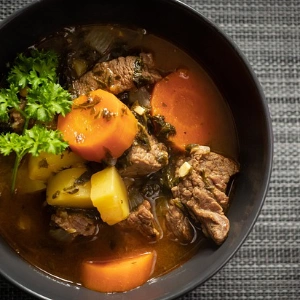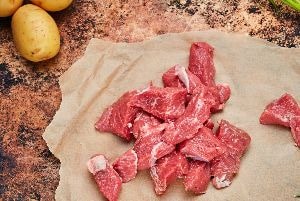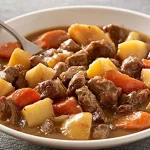Traditional Irish Lamb Stew Recipe
In Ireland we have a lot of rain, everyone who has visited will understand this. Most of our food that we enjoy was normally food that could warm you up, use the best ingredients that are in season and were normally dishes all in one pot.
Growing up in Ireland staying in on a cold winters day meant stories around the fire from Irish mythology or folklore, warm soda bread and often a nice warming stew.
This how to make traditional Irish Lamb Stew recipe is simple but packed with flavour that your family will love and enjoy.
This Traditional Irish Lambs Stew recipe is a great meal that is loved all across Ireland because it is simple, uses ingredients that is in season and you always feel good after eating a piping hot bowl.
For a complete list of all my Irish recipes, click the link to visit my article on Irish Recipes
Table of Contents
Traditional Irish Lamb Stew Recipe

This Traditional Irish Lamb Stew recipe is pretty basic and sticks to the tradition of using meat and vegetables that are in season and packed full of goodness. If you have a local butcher available, you visit him and ask him for the right cut of meat.
In this old fashioned lamb stew Recipe, we will be using lamb as our meat but you can substitute for beef if you wish. For decades, Lamb was traditionally used in Old Fashioned Irish Stew recipes throughout Ireland. If you don’t like lamb, you can easily substitute it.
Normally, tough cuts of meat were used, which needed a long time to cook to become tender. For this traditional Irish stew recipe, I always use lamb neck, shoulder, or leg; lamb rump is also good. Make sure if you are getting it from your butcher, you ask them to remove the bone for you if you are not able to do it yourself, but get him to give you the bones to use for stock.
I use lamb or beef stock in this Irish Stew recipe, but you can also put the bones into the stew to get all the flavour into your meal.
Why Was Lamb Used in Irish Stew?
Lamb is traditionally used to make Irish stews for several reasons:
- Availability: Historically, lamb has been widely available in Ireland due to the country’s temperate climate and lush grasslands, which are ideal for raising sheep. This availability made lamb a common and affordable protein source for Irish households.
- Cultural Heritage: Sheep farming has been integral to Irish agriculture for centuries, and lamb has long been a staple in Irish cuisine. As a result, using lamb in stews reflects a deep-rooted culinary tradition and cultural connection to the land.
- Flavour and Texture: Lamb adds a rich and hearty flavour to stews, with its slightly gamey taste complementing the other ingredients in the dish. The meat becomes tender and succulent when slow-cooked, making it perfect for simmering in a stew until it melts in your mouth.
- Nutritional Value: Lamb is a nutritious meat, rich in protein, vitamins, and minerals such as iron and zinc. Including lamb in stews enhances the flavour and adds nutritional value to the dish, making it a wholesome and satisfying meal.
Overall, lamb use in Irish stews combines practicality, cultural tradition, flavour, and nutritional benefits, making it a beloved and enduring aspect of Irish cuisine.
How to Cook Traditional Irish Lamb Stew
When cooking Old Fashioned Irish Lamb stew, you must cook it over a couple of hours to ensure the meat becomes fork-tender and to allow all the flavours to develop.
This is a very straightforward, one-pot meal you can leave to simmer away, and you will be glad you gave it all the time it needs to cook. I always ensure I add the potatoes at the end of the cooking so they don’t fall apart in the stew.
I use flour in this recipe to slightly thicken it by coating the meat. You can remove the flour if you like and add extra potato at the start of cooking, which will fall apart and thicken your stew. This is also a very traditional Irish way of thickening soups and stews.
Season your lamb stew to taste and serve this with a side of Irish Soda bread or freshly baked rolls with Irish creamy butter.
Enjoy


Traditional Irish Lamb Stew Recipe packed full of flavour and very simple and easy to make. A one pot meal the family will love and enjoy.
- 1 Kg Diced Lamb Preferabley Lamb Neck, Shoulder or Rump
- 1 Bouquet Garni Parsley Stalks, 2 Sprigs of Thyme, 1 Bayleaf tied
- 3 larrge White Onions, sliced
- 4 large Carrots, cut into bite size pieces
- 1 small Turnip/Swede Diced
- 4 Large Potatoes, quartered Place in bowl of cold water to stop browning
- 1 ltr Beef or Lamb stock
- 3 tbsp Plain Flour
- 4 tbsp Oil Rapeseed or any neutral oil
- Salt & Pepper to season
- Finely Chopped Parsley to garnish
-
Place diced lamb in a bowl ans season with salt and pepper generously then dust with flour and mix to coat.
-
Heat a heavy based pot on high heat then add the oil, its important to get the oil really hot. You can add one cube of meat and if you hear a sizzle you know you have it hot enough. Brown the lamb in small batches to prevent stewing the meat. When all meat is brown set to one side. Browning the meat is very important. It adds lots of flavour and colour to the dish.
-
Reduce the heat and add all your vegetables, except the potatoes, into the pan and swet for 5 minutes stirring regulary. Season with salt and pepper. When the onions are translucent add all your meat back into the pot and give it all a good stir to mix.
-
Pour the stock into the pot until it covers all the meat and vegetables and drop your bouquet garni into the stock. Turn the heat up and bring to a boil.
-
Once brought to a boil reduce to the lowest heat and allow to simmer for 2 hours skimming any fat and scum that rises to the surface.
-
After 2 hours add in your potatoes and cook until tender.
-
Taste your stew and adjust the seasoning as needed. Before serving add in the finely chopped parsley and serve pipping hot with some Irish Soda bread on the side.

Can’t wait to try this recipe out. Thank you
I made this today and it is excellent! I feel like I’m eating in a pub in Ireland, but here I am in Florida.
This lamb stew is spot on.
And it consists of ingredients that can be easily found at most grocery stores in the US.
It is not difficult either…just chop, brown, boil and simmer!
The hardest part is waiting 2 1/2 hours or so while I enjoy the luscious aromas permeating the house, while anticipating the flavors!
I’m glad I chose this one out the numerous recipes online, and I surely will make it again!
Thank you very much Patrick, Im glad you tried out this recipe, its a family favourite.